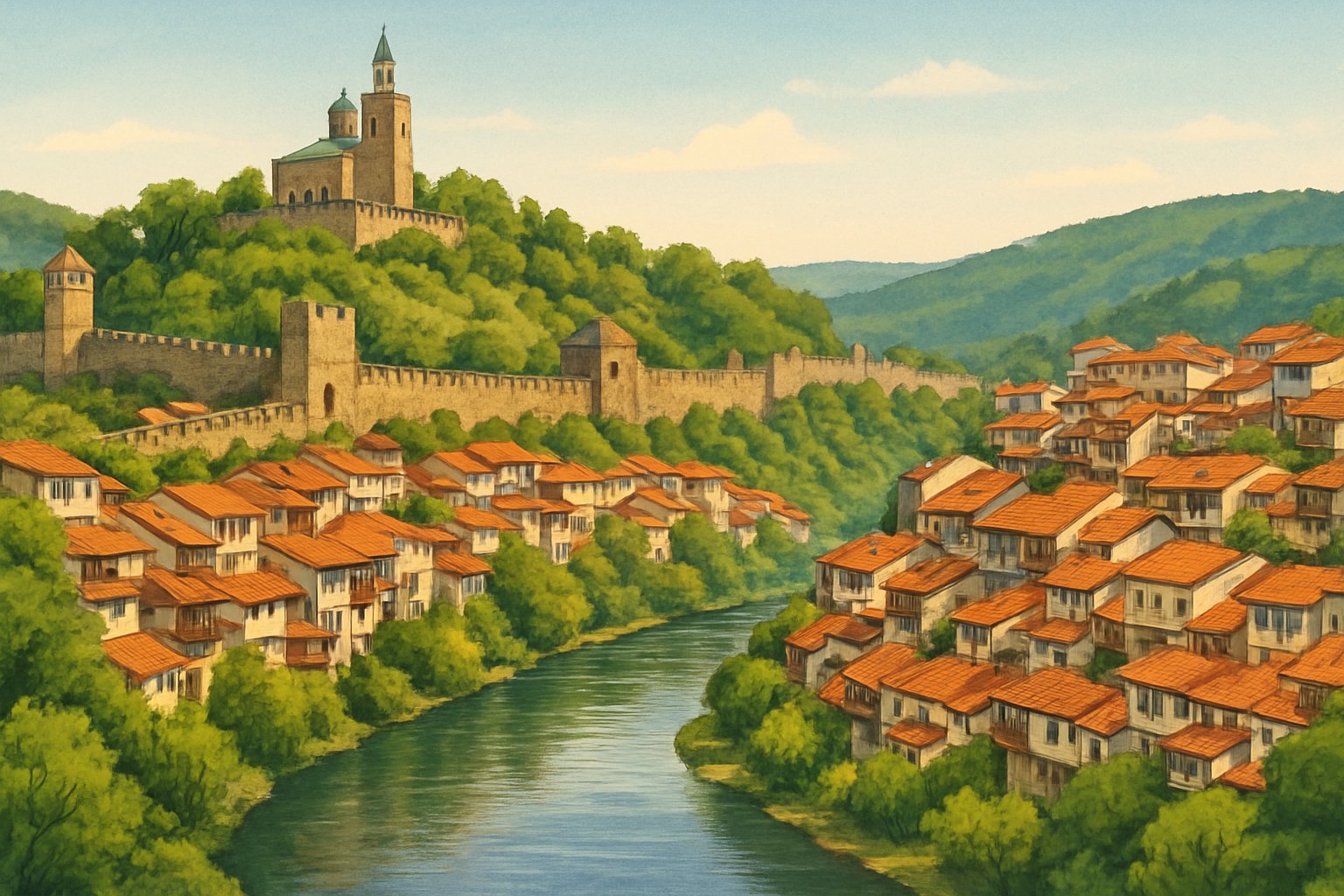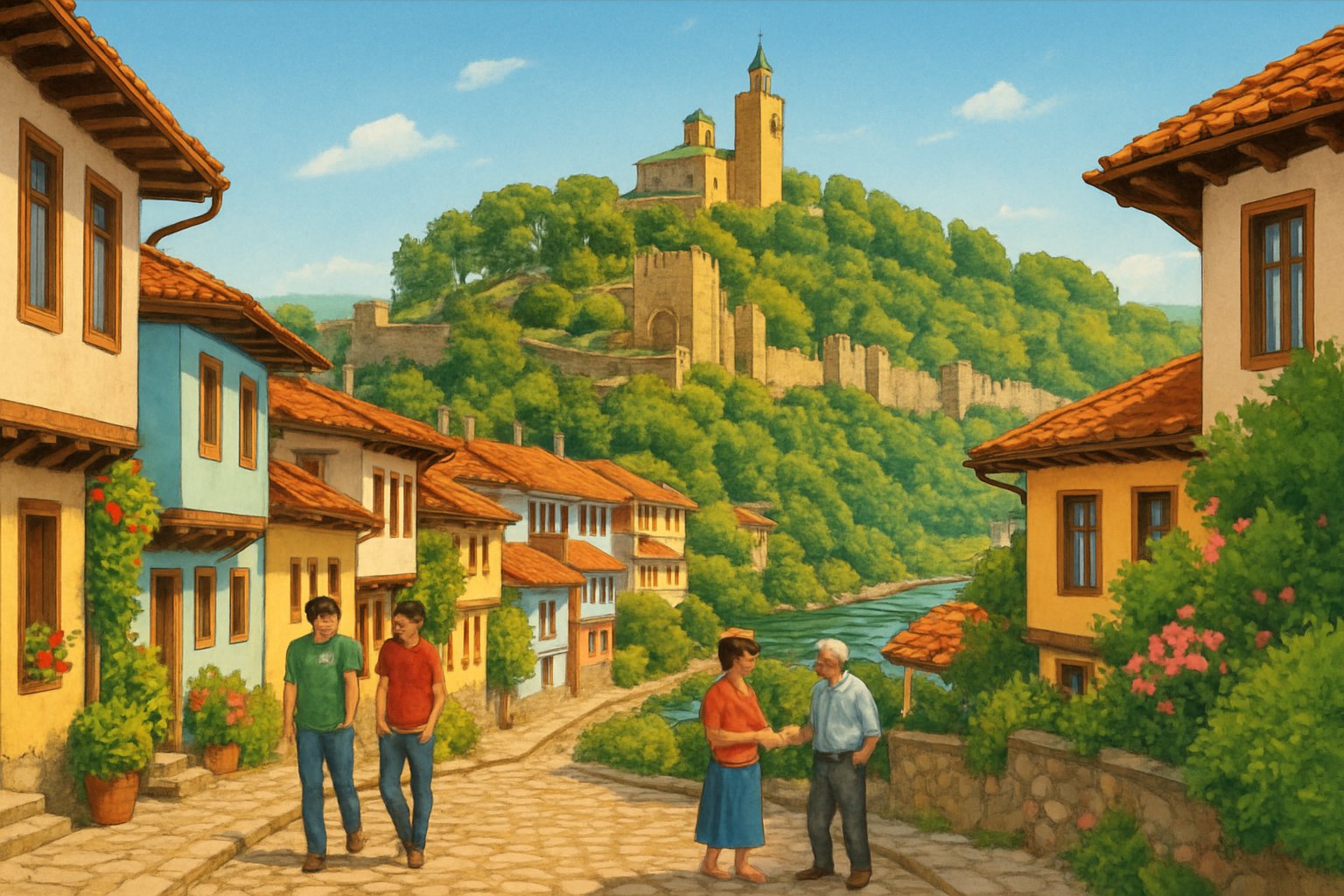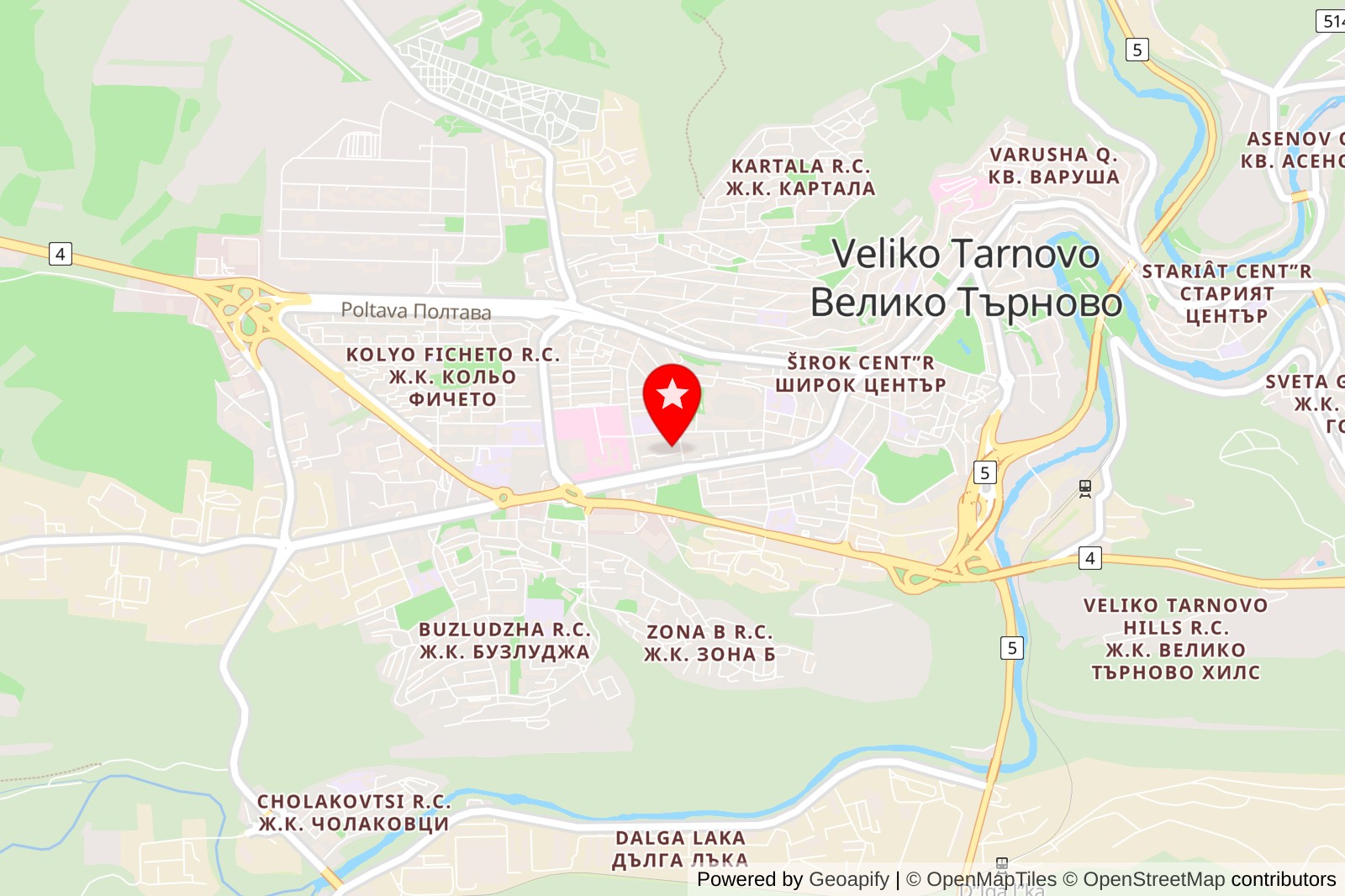Veliko Tarnovo is easily one of Bulgaria’s most captivating spots. Here, medieval history collides with modern-day life along the winding Yantra River.
This city grabs you with its dramatic clifftop setting. Colorful houses tumble down the hillsides, and the historical sites are so well-preserved you can almost hear echoes from Bulgaria’s golden age.

Let’s dig into how this former capital of Bulgaria grew from a powerful medieval stronghold into the lively cultural center it is today. From its reign at the heart of the Second Bulgarian Empire to its current buzz as a beloved travel destination, Veliko Tarnovo is a window into Bulgaria’s heritage and its more modern side.
1) Veliko Tarnovo
Veliko Tarnovo is Bulgaria’s historic capital. Ancient stones here whisper stories of medieval glory.
The town clings to steep hillsides above the Yantra River. Old houses perch over cliffs, and the views are unreal.
We wandered up to the medieval fortress, Tsarevets, and honestly, it blew us away. Its walls tower above the river, and the panoramic views are something else.
Walking those ancient grounds, you really feel the weight of Bulgaria’s history. It’s hard not to get a little swept up in it all.
The old town charms with narrow cobblestone streets and traditional houses. Some buildings seem to dangle right over the cliff—makes for a skyline you won’t forget.
There’s this great blend of old and new. The vibe draws people from all over.
Modern Veliko Tarnovo keeps its historic roots but feels lively and young. The university brings energy, but the city still treasures its culture.
Restaurants, shops, and cafes spill onto the streets. You could spend a whole day just wandering.
Location: Veliko Tarnovo, Bulgaria
Website: Visit Website
Historical Significance of Veliko Tarnovo
Veliko Tarnovo is Bulgaria’s most important historical city. For over 200 years, it served as the capital of the Second Bulgarian Empire.
The city played a huge role in Bulgaria’s fight for independence and its 19th-century cultural revival.
Origins and Medieval Heritage
Veliko Tarnovo is one of Bulgaria’s oldest settlements. People have lived here for over 5,000 years, way back to the 3rd millennium BC.
The Yantra River’s twists and turns made this the perfect spot for a fortified city.
Veliko Tarnovo hit its peak as the capital of the Second Bulgarian Empire from 1185 to 1396. Kings ruled from the mighty Tsarevets Fortress.
Key Medieval Features:
- Tsarevets Fortress – Royal palace and administrative hub
- Patriarchal Cathedral – Spiritual heart of the empire
- Strategic location – Connected West Balkans with the Black Sea
The fortress stood as a symbol of strength after Bulgaria broke free from Byzantine rule. Medieval Tarnovo was a powerhouse, controlling trade routes between Europe and the Middle East.
Role in Bulgarian National Revival
Veliko Tarnovo became a rallying point during Bulgaria’s 19th-century national revival. The city’s medieval glory inspired patriots fighting Ottoman rule.
You can still see this in the churches of Veliko Tarnovo and nearby Arbanasi. These buildings show off medieval Bulgarian architecture and keep old religious traditions alive.
People now call it Bulgaria’s historical and spiritual capital. That title really fits, considering how it helped preserve Bulgarian identity through tough times.
Revival Period Contributions:
- Kept medieval Bulgarian culture alive
- Sparked independence movements
- Maintained Orthodox Christian traditions
- Protected old architectural styles
Culture and Modern Life in Veliko Tarnovo
The city fuses its medieval roots with a lively, modern culture. Traditional festivals meet a growing arts scene, and the local restaurants and cafes are social hubs.
Local Festivals and Traditions
Want real Bulgarian culture? Head to Veliko Tarnovo during one of its annual celebrations.
The big one is the Sound and Light Show at Tsarevets Fortress. During national holidays, the fortress walls become a giant canvas for music, light, and storytelling.
It’s a spectacle—history brought to life right where it happened.
Other local celebrations:
- Easter processions winding through the old town
- Martenitsa festival in March (think red and white bracelets everywhere)
- Rose Festival connections to Bulgaria’s famous rose oil
- Christmas markets in December
Families still make homemade banitsa for New Year’s Day. Orthodox church music and medieval folklore echo through the streets.
The Revival-era buildings create a backdrop that makes every festival feel like a trip back in time.
Art, Food, and Nightlife Experiences
The food scene? It’s a mix of classic and creative. Along Gurko Street, you’ll find excellent shopska salad, banitsa, and kebapche in cozy, family-run spots.
Art galleries dot the old town, featuring local painters and craftspeople. A lot of the work draws inspiration from the city’s medieval walls and river views.
For evenings:
- Wine bars with local Bulgarian wines
- Live music—sometimes folk, sometimes modern
- Rooftop terraces over the Yantra River
- Coffee shops that don’t close early
The university crowd brings energy to the nightlife. Around campus, cafes and bars are packed most nights.
People gather in the main squares on warm evenings, chatting and keeping that old-school Bulgarian sense of community alive.
Frequently Asked Questions

People usually want to know about the best historic sites, how to get here from Sofia, and how to pronounce the name. Some ask about real estate trends, or the city’s population and festivals.
What are the top sightseeing spots in Veliko Tarnovo’s old town?
Tsarevets Fortress is the big one. It’s the main stronghold of the Second Bulgarian Empire, and you can’t miss it.
Samovodska Charshiya is a reconstructed old street lined with craft shops and restaurants. Walking the cobblestones, you can watch artisans work right in front of you.
Baldwin’s Tower gives you sweeping views of the Yantra valley. It’s named after the Latin Emperor Baldwin I, who was imprisoned there in the 1200s.
The Church of the Forty Martyrs is packed with medieval inscriptions and royal tombs. Built in 1230, it holds some of Bulgaria’s oldest historical documents.
How can you get from Sofia to Veliko Tarnovo?
Direct buses leave Sofia’s Central Bus Station several times a day. The trip takes about three hours and costs 15-20 leva.
You could take the train, but you’ll need to change at Gorna Oryahovitsa. It’s about four hours all in.
Renting a car is the most flexible option. The 220-kilometer drive follows the A1 and A2 highways, and the signs are clear in both Bulgarian and English.
What are the recent property trends for houses for sale in Veliko Tarnovo?
Property prices here have stayed pretty steady over the past year. Old town houses usually run between 80,000 and 150,000 euros.
Foreign buyers seem to love renovation projects and historic homes. Lots of folks buy for vacations or retirement.
It’s a buyer’s market—properties can sit for 6 to 12 months. There’s room to negotiate, more so than in Sofia or Plovdiv.
What’s the current population of Veliko Tarnovo?
About 68,000 people call Veliko Tarnovo home, according to the latest census. It’s also the administrative center for the province.
The population’s been pretty stable lately. Some young people leave for Sofia or abroad, but tourism keeps others here.
If you count nearby villages and towns, the greater area is closer to 88,000.
Can you recommend some popular local events to attend in Veliko Tarnovo?
The International Folklore Festival lights up the Tsarevets Fortress every summer. Music and dance groups from all over the Balkans perform with the medieval walls as their stage.
The Sound and Light Show runs from April to October. Watch the fortress come alive with lights and projections telling Bulgaria’s story.
In September, the Medieval Festival brings knight tournaments, craft demos, and even medieval cooking shows.
June’s Rose Festival celebrates Bulgaria’s legendary rose oil. You’ll find rose-picking tours and all kinds of traditional ceremonies.
What’s the best way to learn how to pronounce Veliko Tarnovo?
It’s pronounced “VEH-lee-koh TAR-noh-voh.” Put the emphasis on the first syllable of each word.
Oh, and if you can, try to roll the “r” like they do in Bulgarian. It gives it that authentic touch.
Let’s break it down. “Veliko” means “great.” “Tarnovo” is the historical name.
Both words use soft vowel sounds—think something close to Italian. Not too harsh, just smooth.
Locals usually notice when visitors try to say it right. It might not be perfect, but most people appreciate the effort.
Honestly, hotel staff and tour guides tend to help out if you ask. Why not give it a shot?
You can find audio pronunciation guides in most translation apps. Online dictionaries have them too.
I’d listen to a native speaker a few times to get the rhythm and intonation. That always helps me more than just reading it.

